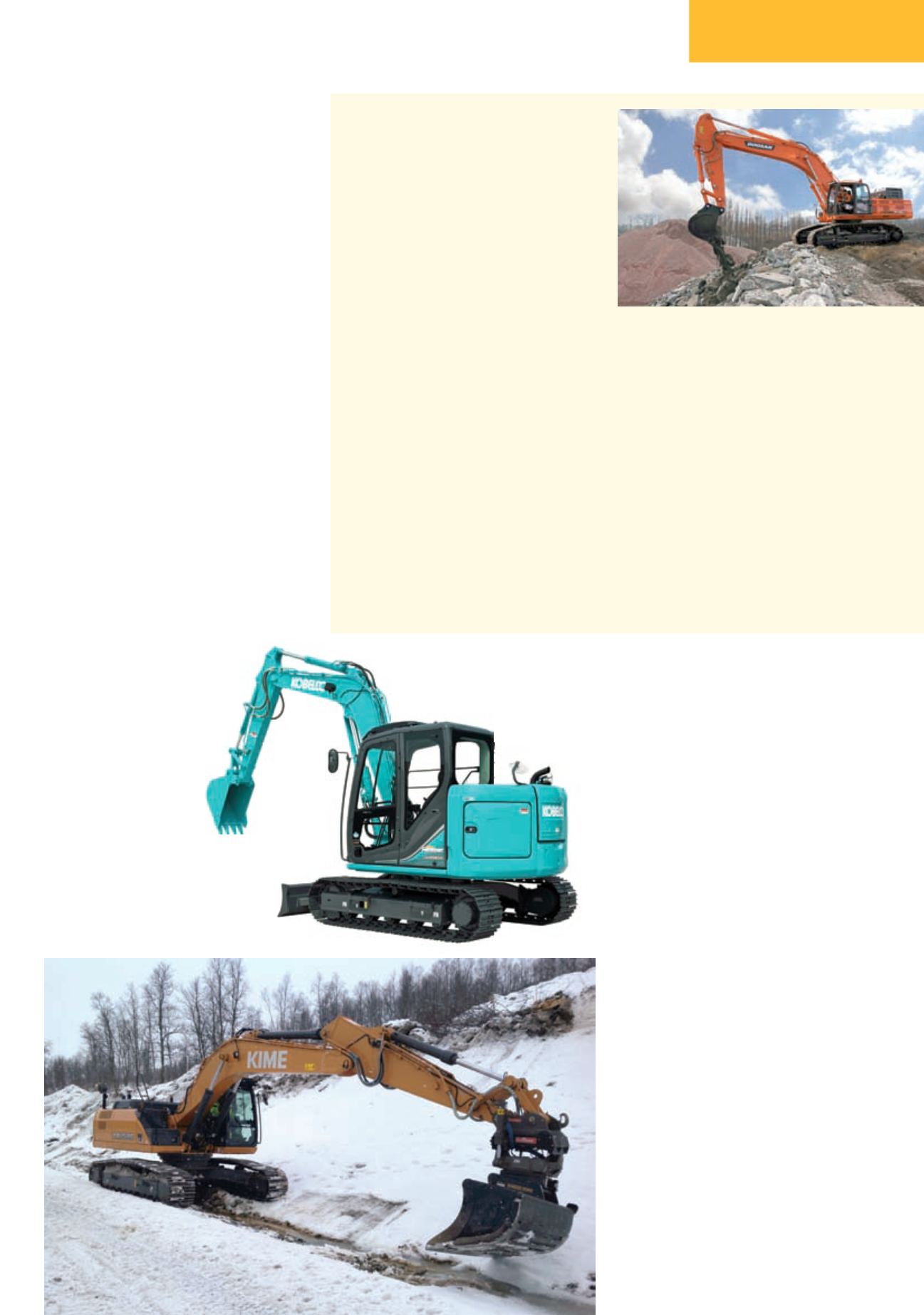
25
d
&
ri
JULY-AUGUST 2013
EXCAVATORS
Doosan’s
new 50
tonners
Doosan has introduced two new Tier 4
Interim/Stage IIIB compliant 50 tonne
class tracked excavators - the 49 tonne
DX490LC-3 (first seen at bauma) and
the 52 tonne DX530LC-3. According to
Doosan, the design of these two new units
is such that they are eminently suitable for
heavy duty work such as large-scale earth
and rock moving, demolition, secondary breaking and loading duties.
The DX490LC-3 weighs in at 49 tonnes, with a digging depth of 7.8 m (25.6 ft), a
dig reach of 12.1 m (39.7 ft) and a dig height of 11.1 m (36.4 ft). The corresponding
figures for the 52 tonne DX530LC-3 are a dig depth of 6.8 (22.3 ft), reach of
10.8 m (35.4 ft) and height of 9.7 m (31.8ft). Both machines are powered by a 6
cylinder Isuzu AL-6WG1X engine delivering 290 kW (389 hp) offering 16% more power,
a 30% increase in displacement and a 41-50% increase in engine torque compared to
the previous DX480LC and DX520LC..
According to Doosan, the DX490LC-3 is a powerful machine with extra reach and
stability to allow it to achieve long cycles and heavy pulling work. A wider undercarriage
on the larger machine provides it with excellent stability and a high lifting capacity. Both
feature new hydraulic pumps and valves that increase digging force by 3-6% and lift
capacity at ground level is up by 5.5% for the DX490LC and 9% for the DX530LC.
New travel and swing components provide an increase in drawbar pull of 15% for both
machines to 38,800 kg (85,360 lb), swing torque is also up 23% to 15,880 kg.m
(115,000 lb.ft) and travel speed is up 10% to 5.5 km/h (3.4 mph).
the right quantity. That means there is no
wasted flow going to a circuit that doesn’t
need it.”
“The hybrid element, the save and re-use
element, captures swing brake energy and
puts it into a hydraulic accumulator.”
In explaining the decision to use
hydraulics to capture waste energy, rather
than more common electrical systems, Ken
acknowledged Caterpillar had gone against
the grain. “The prevailing politics in our
industry is electric. It follows the automotive
industry and that’s how people define it in
their minds,” he said.
However, he continued, “With electrical
systems, you basically have a big alternator
on top of the swing drive. You run it as
a generator to charge a capacitor when
you’re braking and as a motor when you
swing. You’re converting from mechanical
to electrical energy, storing it and then
converting it back. You’re going to get losses.”
“Caterpillar has economy of scale in
hydraulics. I can do a hydraulic system for
one fifth of the cost of an electrical one and I
can get the same performance. We built three
generations of electric hybrids, but we didn’t
sell them because we didn’t believe they could
lower customer costs.”
And expanding on those cost factors he
said, “In most places the 336E H costs about
9% more than the standard machine. I would
estimate customers will save about 25% of
their fuel costs and it’s a pretty
simple equation to work out how
quickly the payback will come –
x months or x hours. And from
a servicing point of view, I also
like the fact that we’re keeping
it all hydraulic.”
“The electric excavator
would have to be about
30% more expensive than
a standard machine.”
Another unusual
factor is that Caterpillar
has chosen a 36 tonne
model as its first hybrid, rather
than the 20 tonne excavators its
competitors have gone for. The
argument for the 20 tonne bracket is
that it is by far the largest segment
of the global excavator market. So why did
Caterpillar go for such a large machine as its
first foray into hybrids?
“The more hours a customer puts on the
machine, the shorter the payback period.
Everyone who buys a 336 is going to put
at least 1,500 hours on it a year on it. More
commonly it would be 2,000 hours, and
often much more than that. The payback
period was always going to be shorter for a
production machine like this than a 20 tonne
machine. I know there are 20 tonne machines
in production applications, but it would be a
small proportion of that class.
“What customers were telling us was that
they payback period had to be three years or
less. We targeted 18 months, and the hour
usage pattern of a 336 fitted that well,” said
Mr Gray.
According to Ken, various elements of the
technology on the 336E H will start to be seen
on other machines, based on what will lower
costs for customers and provide a quick pay-
back. In fact in the future, he believes this type
of technology will be standard.
“I probably won’t even call the next
generation ‘hybrid’. I think the technology is
going to be pervasive. For a 75 or 90 tonne
machine it’s a no-brainer. You just put it in.”
While Caterpillar has designed its own
systems for the 336E H – systems we can
Norwegian Case dealer Dagenborg Maskin modified
a CX250C excavator so it can be operated using a
single joystick. The modification was needed after
operator Thomas Rostad lost much of his right hand
in an accident
At 49 tonnes, the DX490LC-3 is the smaller of two
new Doosan 50 tonne class machines
>
26
Having dissolved its joint venture with CNH at
the end of last year, Kobelco is now free to
sell its excavators anywhere in the
world, and is putting together dealer
networks in Europe
and North America


